I hope the bobcat that I wrote about in my last blog is OK. It may not have looked like it was very injured, but we couldn’t see its underside and a single barb or point of barbed wire that cuts through the animal’s skin as the animal goes through the fence can cause a serious laceration and possibly expose and tear muscle and other tissue below the skin. A laceration can lead to infection and death. It can also attract flies which will lay eggs in the wound. Once that happens it’s just a matter of time. The animal seeks cover at some point and is never seen again.
I’ve been concerned for some time about the harm barbed wire fencing can do to wildlife. What got me started was seeing the photo below of a deer caught in a barbed wire fence in late 2011.

The photo was taken by my friend, Larry Thorngren. If you click here you can read about the incident. The deer was alive, but the legs were lacerated to the bone. The deer was beyond saving and therefore shot. A sad event and an unnecessary death. As you will come to understand below, this deer got caught in the fence because its hind feet did not clear the top wire and there was not enough clearance between the top wire and the wire below it. The result is sometimes referred to as “scissoring.”
The photo prompted me to search the internet to see what I could find about barbed wire fencing and wildlife. The first thing I found was a paper published in 2009 by the Colorado Division of Wildlife entitled “Fencing with Wildlife in Mind.” A little later I found a 2008 document published by the Montana Department of Fish and Wildlife entitled entitled “A Landowner’s Guide to Wildlife Friendly Fences.” It was the basis for much of the Colorado paper. That Montana document has been followed by a later edition: “A Landowner’s Guide to Wildlife Friendly Fences,” Second Edition, 2012, Montana Fish Wildlife and Parks (hereafter “Montana Fencing Guide” or “Guide”). The document (both editions) was written by Christine Paige, Ravenswood Ecology, Jackson, Wyoming. To download and/or read the document click here and then click on the second-listed link. The Guide has been used by several other state wildlife agencies in developing their own guides to fencing.
The Guide starts off acknowledging that fences are needed to control livestock, but that they can also be hazards to wildlife, including birds. It describes fences that are harmful and how to build fences that are not harmful. There are several pictures showing animals killed by fencing, primarily barbed wire fencing. Note also that the title says it is a landowner’s guide. It was prepared for ranchers who want to use fencing methods on their lands that are considerate of wildlife. Most ranchers in Montana and the other western states have a relatively small private land holding, obtained originally under the Homestead Act or some other federal land disposal law, and a larger area of Bureau of Land Management (“BLM”) land that they use for livestock grazing under federal grazing permits. The Guide’s purpose is to show ranchers how to construct or modify fences on their land that restrain livestock, but not wildlife. Wild animals, unlike domesticated cattle, need to travel daily in search of food, water and cover; and, at appropriate times, to mate and give birth. Fences impede that necessary travel.
One of the things the Guide reports on is a two-year study of wildlife deaths caused by 600 miles of fencing in an area of northeast Utah and northwest Colorado. The study found that, on average, one ungulate (deer, elk or pronghorn) per year was found tangled (and dead) for every 2.5 miles of fence (at 600 miles that’s 240 animals per year). Most ungulates (69% juveniles and 77% adults) died by getting caught in the two top wires while trying to jump the fence. See photo of the deer above. 70% of all deaths were on fences higher than 40 inches.
We don’t know how many animals die each year at Point Reyes due to barbed wire because no one is inspecting all the miles of fencing every day. Some animals do die and still others are injured.
An example of what barbed wire can do to animals at Point Reyes is the skull of this large bull elk below. It died a horrible death. This should not happen anywhere, but especially not in a national park. This animal’s skeleton was found on Mt. Vision above Home Ranch. Note how the left antler split into two antlers.
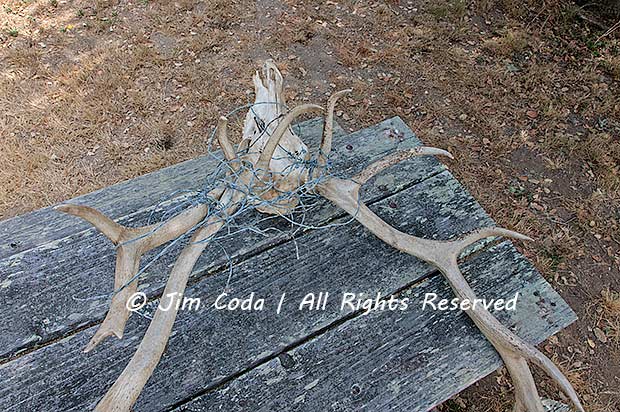
I don’t know how the barbed wire became so tangled on this poor creature, but I’ve seen several pictures on the internet of elk with barbed wire in their antlers. In this case the wire wrapped around the bull’s lower jaw and cut half way through the jawbone over time as it tried to eat and drink. See next photo.
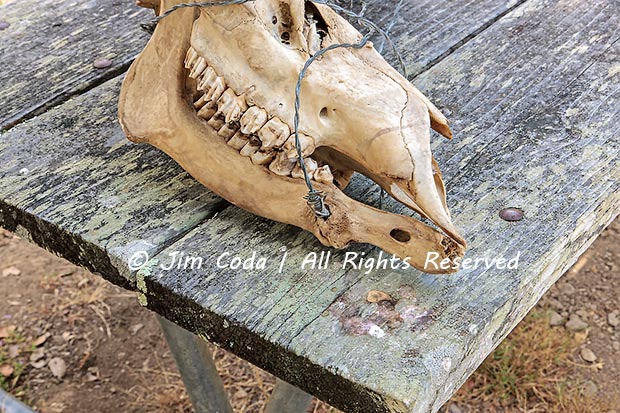
The wire was either (1) attached to a fence in the normal manner, (2) detached in part, or (3) completely separated from a fence and laying on the ground, possibly in coils. During the rut, bulls (and buck deer) will spar with bushes or anything on the ground and that may be what happened here. The wire could have been on the ground and/or tangled in some brush. Anyway, before long the wire wrapped around his antlers.
If you look closely you can see the barbed wire crossed the bridge of its nose which prevented the lower jaw from opening much. Note how the elk’s attempts to open its lower jaw to eat and drink caused the barbed wire to cut into the bridge of its nose. We don’t know how long this poor elk suffered.
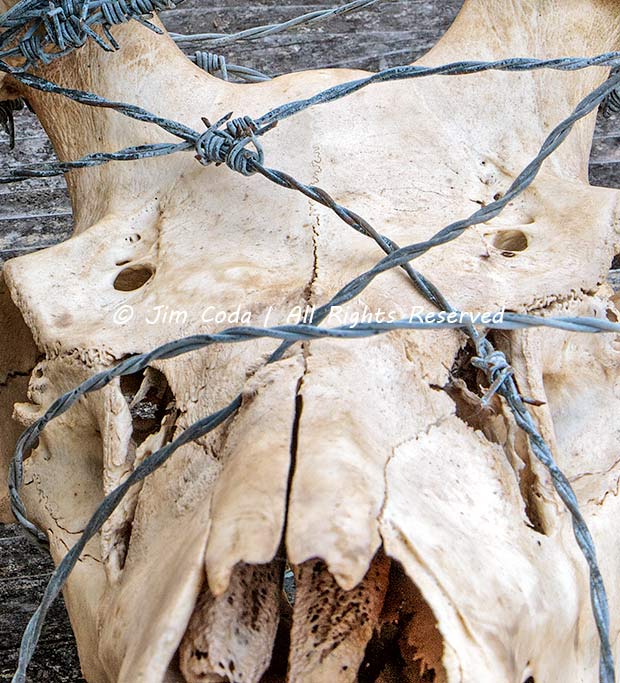
Note the sharpened barbs in the photo and the photo below. What is barbed wire? It’s twisted steel wire (two strands of wire that are twisted (see photos)) with sharp points at intervals of three, four or five inches. Barbs come in two versions, two-point or four-point. It’s been used in wars (e.g., the beaches at Normandy), around prisons (and concentration camps in WWII) and any other time someone wants to restrict movement of people or animals. It’s the cheapest way to restrain cattle. It’s sold in reels of 1/4 mile in length and it only costs about $60-$70 per reel. It’s also very light at 40 to 80 pounds per reel depending on the gauge of the wire. It lasts from about three to ten years. It’s galvanized, but still rusts and eventually fails. The sharpened barbs are quite capable of puncturing and tearing flesh. The barbs are over 1/2 inch long.
Here’s a photo showing more closely what the barbs look like.
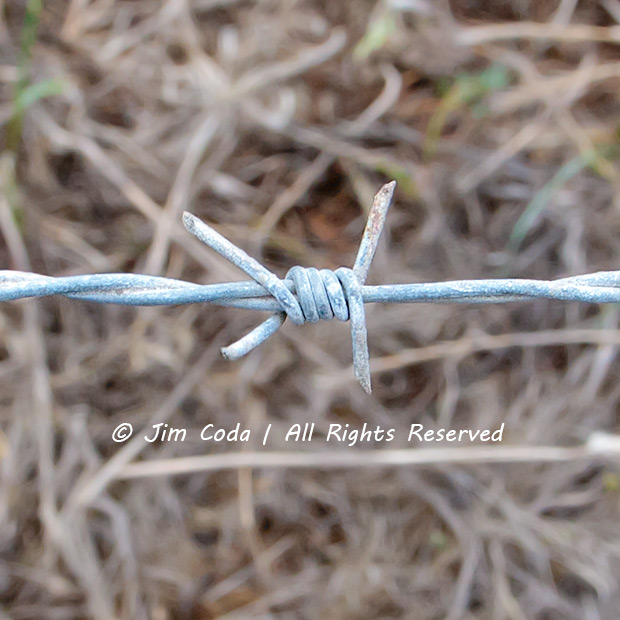
Given the harmful nature of barbed wire, it should be used at Point Reyes only under the most stringent and safe conditions, if at all. The wildlife there deserve no less.
Getting back to the Montana Fencing Guide, it describes a wildlife-friendly fence as follows: It should allow animals to jump over or crawl under it without injury. Page 10. It should be highly visible (white pvc pipe around the top wire or flagging at regular intervals) so animals don’t run or fly into it. Id. The top wire should be low enough for adult animals to jump over, preferably 40 inches, but no more than 42 inches; the distance between the top two wires should be 12 inches, preferably 14 inches, so elk and deer won’t tangle their back legs with the top wires (like the deer in the first photo above). Id. The bottom wire should be at least 16 inches, preferably 18 inches, from the ground. Id. The top and bottom strands should be “smooth wire” (like regular two strand twisted barbed wire, but without the added barbs) so animals don’t get snagged and injured. Id. Posts should be at 16.5 foot intervals. Id. In areas where fences must be built on slopes, the degree of slope must be taken into account. A 42 inch fence on a 30 degree slope is equal to a 62 inch fence if the animal is standing on the lower side of the fence. Id. at 9. Fences should be three wire, preferably, or four at most. Id., at 32.
I’ve been wondering for a while whether BLM had any standards for fencing regarding wildlife. I thought that if any federal agency would have such standards it would be BLM because it manages millions of acres of public lands used for grazing by ranchers in the western states. As I was writing this post I finally did a search and found that BLM does in fact cover fencing in its manual. The fencing portion of the manual can be found here.
It’s 57 pages in length and a considerable amount of it is focused on wildlife. It generally follows what the Montana Fencing Guide says with slight variations. It’s important to understand that it wasn’t written as a suggested guideline for ranchers for their private property, but to be the standard for fencing on the federal land managed by BLM. It should also be kept in mind that BLM is a “multiple use” agency (i.e., with many responsibilities, including grazing, mining, timber, recreation, wildlife, etc. which are often in conflict and of equal weight, generally), in contrast to the Park Service whose job it is, above all, to “conserve the scenery and the natural and historic objects, and the wild life [sic] therein.” 16 U.S.C. § 1.
Before addressing the specifics of fencing in the BLM Manual, here is some prefatory language to more fully understand the standards:
2. Deer, Elk, or Moose Habitat.
a. Limitations.
(1) Woven wire, 5- or 6-strand barbed wire fences and fences exceeding 42 inches in height all pose serious problems for deer … When the lower strands of wire are both close to the ground and to each other, they impede movement of fawns and yearlings which tend to go under or through a fence.
(2) Normally, deer jump with their hind legs forward. If the top two wires are too close together or loose, deer often tangle their hind legs, resulting in broken legs, entangled animals dying of starvation or shock, and broken fences. Elk jump the same way, but usually move on after breaking the fence or injuring themselves. Within elk herd movement areas, fence damage can be extensive.
b. Standards. Illustrations 1 and 2 depict fencing standards to be used in deer, elk, or moose habitat.
BLM Manual, IV-5 and IV-6. (Emphasis added.)
Illustration 1 is a table which shows combinations of livestock and wildlife species using the same land. It shows that when you have deer and elk in an area where cattle and sheep graze you should use three-wire fencing. It should be 38 inches high and there should be 16 inches clearance on the bottom and 12 inches clearance between the top wire and the middle wire. It also states that the bottom wire must be smooth. Illustration II uses drawings instead of words to show how each fencing situation looks in terms of height and spacing of wires for the various combinations of wildlife and livestock.
So, how do the fences at Point Reyes stack up to the BLM Manual and the Montana Fencing Guide? I developed a sense over the past 2.5 years that the fencing was not good. I did some measuring at various times and knew heights and clearances between wires were bad, but I didn’t keep records of those measurements. Based on three recent trips to measure a number of fences I can say that all the pastoral fences I measured failed the BLM standards and the Montana Fencing Guide on almost all counts.
The discussion below is based on 20 fence measurements on what I believe was 12 ranches (not always clear where one ranch ends and the next one begins). For simplicity’s sake, I decided to use one of the two sets of standards/guidelines. I decided to use the BLM standards because BLM is a federal agency (a sister agency, no less) and because, like the Park Service, it owns the lands being fenced. As you’ll recall, the BLM standards are no more than three strands; 38 inches in height; 16 inches clearance at bottom; 12 inches clearance between the top wire and the next wire and the bottom wire must be smooth. (The fences wouldn’t have fared any better under the Montana Fencing Guide as you’ll see if you keep those guidelines in mind when reading below.)
Of the 20 fences, none met the 38 inch height limit; only four met the 16 inch clearance requirement at the bottom; and none had smooth wire at the bottom. Eight of the 20 were five-strand fences that are not allowed under BLM’s manual (or the Montana Guide), one was a six-strand fence and the rest were four strand fences. Thus, none met BLM’s three strand requirement. Finally, all failed the 12 inch clearance requirement between the top two wires. The deer in the photo at the top got tangled in the fence because the top two wires were too close together. The Utah-Colorado study found almost 75% of the animals died because the top two wires were too close together.
The six-strand fence I found was especially egregious. It’s 48 inches high with only 9 inches between the two top wires and, instead of 16 inches of clearance at the bottom, there was one wire at 6 inches and another at 11.5 inches. How does a deer fawn get through that? There is a little more space between the second and third wires. The third wire is 21 inches from the ground. That leaves a space of 9.5 inches between the second-lowest wire and the third-lowest wire. How big is that? I got out the metal ruler I used in the park and laid my little finger on the zero and stretched my thumb and got to 9.5 inches. Same as the space in the fence. Looking at my outstretched palm, a deer fawn couldn’t get through that with those long gangly legs. Furthermore, it is much easier for a fawn to crawl under one wire than to pick its way between wires. If a fawn can’t get past a fence it just lays down and waits for its mother to come back (and sometimes they don’t as reported in the Montana Fencing Guide). A coyote couldn’t get through there either. It would even be iffy for a bobcat. Maybe this is where the bobcat that I wrote about in my last blog ran into trouble. As for the 48 inch height, as BLM says, five-strand or six-strand fences and fences over 42 inches “pose serious problems for deer.”
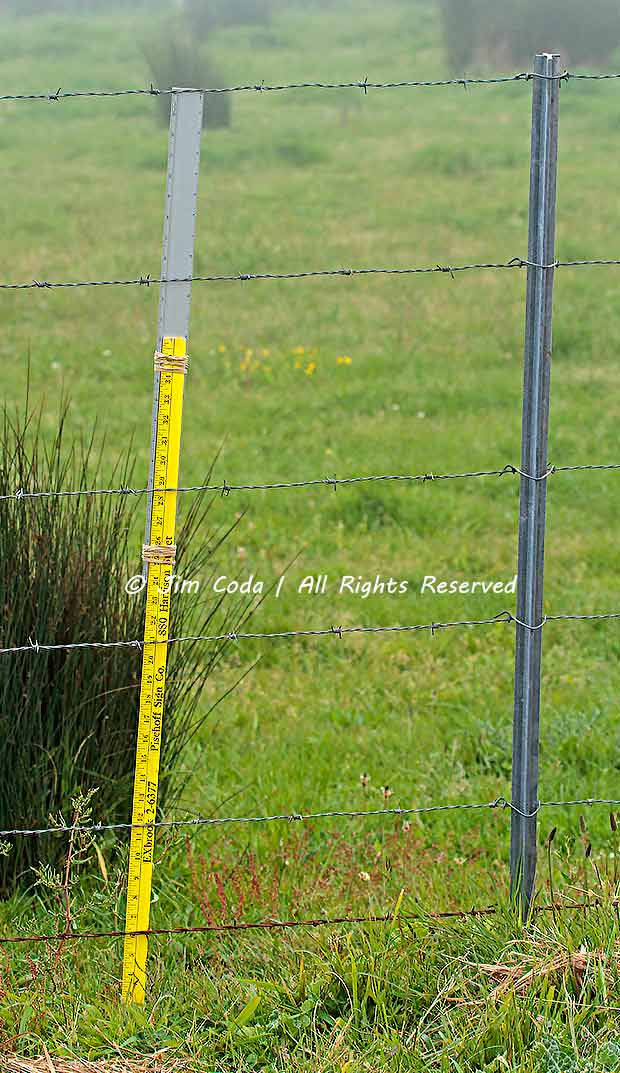
Because there has been so much coverage in the news about elk breaking fences on the C Ranch’s side of Drakes Beach Road I took several measurements there. I found three spots along the road that had broken wires. The first broken fence section was just after turning onto Drakes Beach Road. The top two stands were broken. The ground was covered in what I think was poison oak so I didn’t measure there.
The next break was of a top strand. It was 44.5 inches high (on the portion still attached to the post) and the clearance between the top wire and the next wire was only 9.75. The last broken wire was a second wire just a short distance toward the beach from the previous break. It measured 42.25 inches at the top and the clearance between the top two wires measured 10.75 inches, but it would have been slightly less if the second wire hadn’t sagged some because of the break that began on the other side of the post.
Fortunately, the wires on these two areas of the fence line broke. If they hadn’t, the animal’s feet would have been caught in a “scissors” hold by the wires and the animal would have been helpless as was the case of the deer at the beginning of this blog.
I want to point out first that we don’t know how those strands broke. In the case of the fence panels in the poison oak and the second break of the two breaks I did measure, the wires that broke were rusted (and are now laying on the ground, which is not good). They could have failed on their own and, in any case, probably weren’t as strong as when they weren’t rusted. Finally, a cow could have broken one or more of them.
But let’s assume for the sake of discussion that elk broke the wires. As for the two I measured, no wonder the top two strands broke. We know from the BLM Manual and the Montana Guide that the fence is too high along the road and there isn’t enough clearance between the top two wires. This is a recipe for broken fences and injured or dead elk (and deer).
If an elk or deer doesn’t clear the top wire, and if the wire below the top wire is high enough to catch the animals lower rear legs/hooves as they rotate back under the top wire, then the animal becomes trapped or “scissored” by the two wires. In that case the animal hangs from the fence with the weight of its upper body making it a prisoner of the wires until it dies or is rescued by a human. See first photo above. Even if a human comes along (with the necessary heavy wire cutter or bolt cutter), there is no guarantee the animal will live. The deer in the first photo had to be shot. The best case is that the elk or deer breaks one or both top strands and therefore doesn’t get “scissored.” However, even in that case, the animal can suffer lacerations or other injuries, such as broken legs, that can lead to death. If elk (or deer) broke these fences, they may have been injured and their injuries may have resulted in their deaths.
This is absurd. More important, it’s inhumane. Given the fact that elk inhabit this area and they are breaking these too-tall fences, with top wires too close together, this should be treated as an emergency and the fences on the west side of Drakes Beach Road ( and perhaps the east side) should be modified per the provisions of BLM’s Manual and/or the Montana Fencing Guide. This should be done before any more fence wires are broken and elk (or deer) are injured or killed.
I should mention that the Park Service has installed wildlife crossing fence panels at one spot on each side of the road. The top wire(s) were removed and replaced with 4×4 posts installed parallel to the ground. The tops of these 4x4s are 34 inches from the ground. The elk seem to prefer crossing at these spots and I don’t think any cattle have crossed them. A couple more of them along each side of the road would seem likely to prevent more broken fences and injuries or deaths to elk (or deer) there.

I need to say some more about broken fences at Point Reyes. There are broken fences everywhere in the pastoral zone. The three fences along Drakes Beach Road are not unusual at all. Here’s one of the photos I took of broken fences. This one is on the Tomales Peninsula. Note the condition of the old, rusty wire. If a deer crosses here it could get its legs tangled in the wire.

Here is another broken fence on the Tomales Peninsula. Let’s take a closer look. There are two wires coming off the top of the post. They appear to be relatively new in that they show no rust. The top wire is intact, so why is either of them attached to the top of the post? Below them there is a third wire that is broken (for unknown reasons) and hanging down from the post. I assume it ran from this post to the post to the left of it. It doesn’t appear rusty either. All three wires seem to be quite long and all are laying on the ground. Some have loops in them. They are all hazards for wildlife, especially any buck deer that would be looking for things to joust with during the rut.

Leaving fencing like this along fence lines is just asking for some animal to get caught in it. The Park Service needs to patrol for this kind of thing and require the rancher to fix it immediately.
In summary, the Park Service needs to establish a fencing policy for all fencing at Point Reyes. It should adopt the most stringent standards in the BLM Manual and/or the Montana Fencing Guide. After all, unlike ranchers in Montana, and BLM with its multiple use mission, the Park Service has a legal mandate for every park to “conserve the scenery and the natural and historic objects and the wild life [sic] therein ….” 16 U.S.C. Section 1. (Emphasis added.) The Point Reyes statute goes on to say the Secretary shall administer the property “without impairment of its natural values.” 16 U.S.C. § 459c-6. Wildlife is clearly one of its natural values.
On the other hand, ranching is only allowable to the extent it doesn’t interfere with the Park Service’s statutory mission to conserve wildlife and doesn’t impair the park’s natural values (including wildlife). It is discretionary under the statute and, if allowed, “shall be subject to such restrictive covenants as may be necessary to carry out the purposes of” the Point Reyes statute. 16 U.S.C. § 459-6. Again, “purposes” includes wildlife. Ranching is not a purpose of the park. If it were, the statute wouldn’t be worded the way it is.
If the fencing standards above are followed at Point Reyes, wildlife is much less likely to get injured or killed and much less likely to damage fencing.
Addendum: I thought this post was going to end with the previous sentence. However, as I was reviewing the draft, I decided to call the park to see if there was any fencing policy or guideline used by the park. I hadn’t found any national fencing policy for the Park Service so I wasn’t expecting anything. However, I learned the park has developed a set of specifications that it uses whenever the park hires a contractor to build a fence for its own reasons, like excluding cattle from creeks or other sensitive areas. I was told it is also the spec that is referenced in some or all leases/permits for any fencing done by ranchers. It is as follows: Five strand; 48 inch high; bottom clearance 12 inches; clearance between all other wires, including the top two wires, 9 inches. The top and bottom wires are to be smooth.
Every part of these specs is contrary to both the BLM Manual and the Montana Fencing Guide, with the exception of smooth wires. The park should modify its fencing specs and its fences immediately to meet the specs of the BLM Manual and/or the Montana Fence Guide. Furthermore, why isn’t excluding cattle from creeks and other sensitive areas a rancher obligation and cost? Why should the Park Service use park funds to subsidize the ranchers? Finally, because this fencing also excludes deer and elk from creeks, where are they supposed to get their water?
The pastoral zone is essential habitat for all sorts of wildlife, yet it seems no one is taking wildlife into account there.
Second Addendum: I erred in including the special fence the park installed along Drakes Beach Road as one of the 21 fences measured. It isn’t a regular barbed wire fence with its 4×4 wood post at the top and angled wires beneath. I’ve gone back and changed the number “21” to “20” where “21” appeared. No other changes are necessary because I didn’t use that fence for any of the measurements discussed.
